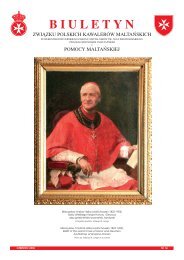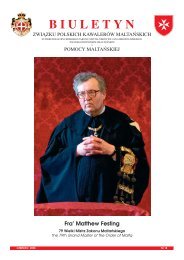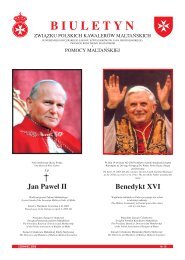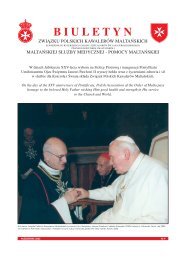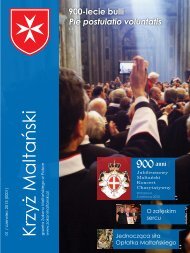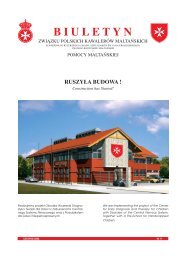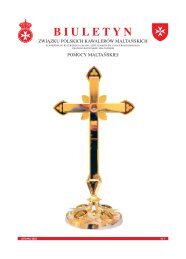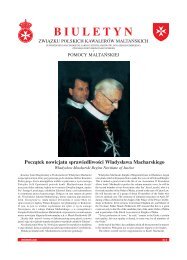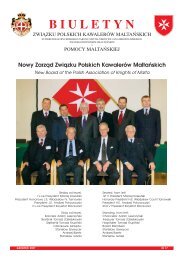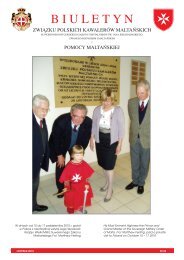Nr.10 - Zakon Maltański Polska
Nr.10 - Zakon Maltański Polska
Nr.10 - Zakon Maltański Polska
Create successful ePaper yourself
Turn your PDF publications into a flip-book with our unique Google optimized e-Paper software.
Życie duchowe<br />
Spiritual life<br />
przez Francuzów. Po jego rezygnacji<br />
wraz z kawalerami z Malty ikona<br />
schroniła się w Petersburgu pod<br />
skrzydła cara Pawła. W tym<br />
momencie losy ikony i <strong>Zakon</strong>u<br />
rozchodzą się. Ikona bowiem zostaje<br />
w Petersburgu, w Pałacu Zimowym.<br />
Szczęśliwie gdy krążownik<br />
„Aurora” daje sygnał do ataku, ikona<br />
znajdowała się w kaplicy poza<br />
miastem, gdyż właśnie obchodzono<br />
uroczystości ku czci <strong>Zakon</strong>u. W<br />
końcu w roku 1920 wywiozła je<br />
cesarzowa−wdowa Maria Fiodo−<br />
rowna do swej ojczyzny – Danii. Po<br />
jej śmierci ikona dostała się królowi<br />
jugosłowiańskiemu Aleksandrowi I.<br />
Wobec niebezpieczeństwa niemiec−<br />
kiego najazdu ikona zostaje<br />
przeniesiona w roku 1941 do<br />
klasztoru w Czarnogórze. Odtąd<br />
słuch po niej ginie...<br />
Istniała wszakże kopia, którą car<br />
nakazał wykonać, by ikona nie była<br />
narażana na niebezpieczeństwa w<br />
czasie procesji. Ta kopia znajduje się<br />
w kościele Matki Bożej Anielskiej w<br />
Asyżu.<br />
Tymczasem oryginał był ukryty<br />
w Czarnogórze. Opiekujący się nim<br />
mnisi strzegli zazdrośnie ikony przed<br />
zakusami Belgradu. Milicja „zaaresztowała” ją, ale w końcu<br />
władze zdecydowały się umieścić ikonę w muzeum narodowym<br />
Czarnogóry w Cetinje, gdzie obraz ten nie był eksponowany.<br />
Stan ikony konserwatorzy oceniają jako dobry, co jest<br />
zaskakujące biorąc pod uwagę jej burzliwe losy.<br />
Ikona<br />
Matki Boskiej<br />
z Filermo<br />
The icon<br />
of the Madonna<br />
of Philermo<br />
by the French. After his resignation,<br />
the icon and the Knights from Malta<br />
found refuge in St. Petersburg, under<br />
the wing of Tsar Paul. At that point,<br />
the fates of the icon and the Order se−<br />
parated – the icon remained in St. Pe−<br />
tersburg, in the Winter Palace.<br />
When the battleship “Aurora”<br />
gave the signal for the attack during<br />
the Bolshevik Revolution in 1917, for−<br />
tunately the icon was located in a cha−<br />
pel outside the city, for observances<br />
in honor of the Order. In 1920, it was<br />
removed by the dowager empress Ma−<br />
ria Fiodorowna to her country, Den−<br />
mark, and after her death in 1928,<br />
eventually came into the possession<br />
of Yugoslav king Aleksander I. In the<br />
face of the threatening German inva−<br />
sion, the icon was transferred to the<br />
monastery in Montenegro in 1941.<br />
From that point, all traces of it disap−<br />
peared.<br />
There was a copy, made on the or−<br />
der of the Tsar so that the original<br />
would not be damaged during proces−<br />
sions. That copy is found in the church<br />
Santa Maria degli Angeli at Assisi.<br />
Meanwhile, the original was hid−<br />
den in Montenegro – the monks guar−<br />
ded it zealously from the administra−<br />
tion in Belgrade. The police “re−arrested” it, but finally the au−<br />
thorities decided to place the icon in the national museum of Mon−<br />
tenegro in Cetinje, where it was not put on display.<br />
Conservators assess the state of the icon as good, which is<br />
surprising considering its tumultuous history.<br />
Historia<br />
History<br />
SZPITAL MALTAŃSKI W WARSZAWIE<br />
The Maltese Hospital in Warsaw<br />
Aleksander Cieślak<br />
Podstawowymi obowiązkami rycerzy maltańskich były przez<br />
całe wieki walka za Wiarę i pomoc „naszym Panom<br />
Ubogim”. Mówi o nich już pierwsza reguła <strong>Zakon</strong>u, a<br />
powtarzają za nią kolejne dokumenty wystawiane przez<br />
Wielkich Mistrzów, przeorów, a w XX w. statuty Związków<br />
Narodowych. Obowiązki te były zapisane także w<br />
przedwojennym Statucie Związku Polskich Kawalerów<br />
<strong>Maltański</strong>ch, który w trzecim paragrafie stanowił: „Celem<br />
Związku jest opieka nad chorymi i rannymi tak w czasach<br />
pokojowych, jak przede wszystkim w czasach wojennych<br />
oraz charytatywna działalność wszelkiego rodzaju z<br />
wykluczeniem celów zarobkowych”.<br />
POCZĄTEK<br />
Przez cały okres międzywojenny ZPKM zakładał na terenie<br />
Polski szpitale lub sanatoria i w chwili wybuchu wojny posiadał:<br />
szpital−sanatorium w Rychtalu, szpital Juliusza w Rybniku oraz<br />
szpital im. Ferdynanda Radziwiłła w Ołyce. Od początku swego<br />
istnienia Związek Polski współpracował też z władzami<br />
Through the ages, among the fundamental duties of Knights<br />
of Malta were fighting in defense of the Faith, and bringing<br />
aid to “our Lords the poor.” The first rule of the Order speaks<br />
of these duties, and they are repeated in successive docu−<br />
ments issued by Grand Masters, by Priors, and, in the 20 th<br />
Century, by the bylaws of the National Associations. The du−<br />
ties were also spelled out in the pre−war Constitution of the<br />
Polish Association of Knights of Malta, whose third paragraph<br />
read: “The mission of the Association is to extend care to the<br />
sick and wounded, both in peacetime and especially in ti−<br />
mes of war, and to conduct all manner of charitable activi−<br />
ties, excluding profit−making aims.”<br />
THE BEGINNING<br />
Throughout the inter−war period, the Polish Association had<br />
founded hospitals and sanatoria in Poland, and at the outbreak of<br />
the war, had these: a hospital−sanatorium in Rychtal, the Julius<br />
Hospital in Rybnik, and the Ferdynand Radziwiłł Hospital in<br />
Ołyka. From the beginnings of its existence, the Association co−<br />
Strona 8 CZERWIEC 2004



